At
the bottom of the portal silo I saw the battered and rusty elevator
car. It looked like parts were missing but I couldn't be
sure. Large vault-style doors stood partially open and were
streaked with rust. The floor was wet and covered with rusty mud
and it smelled like the inside of an engine block recovered from the
bottom of a deep lake down there.
|
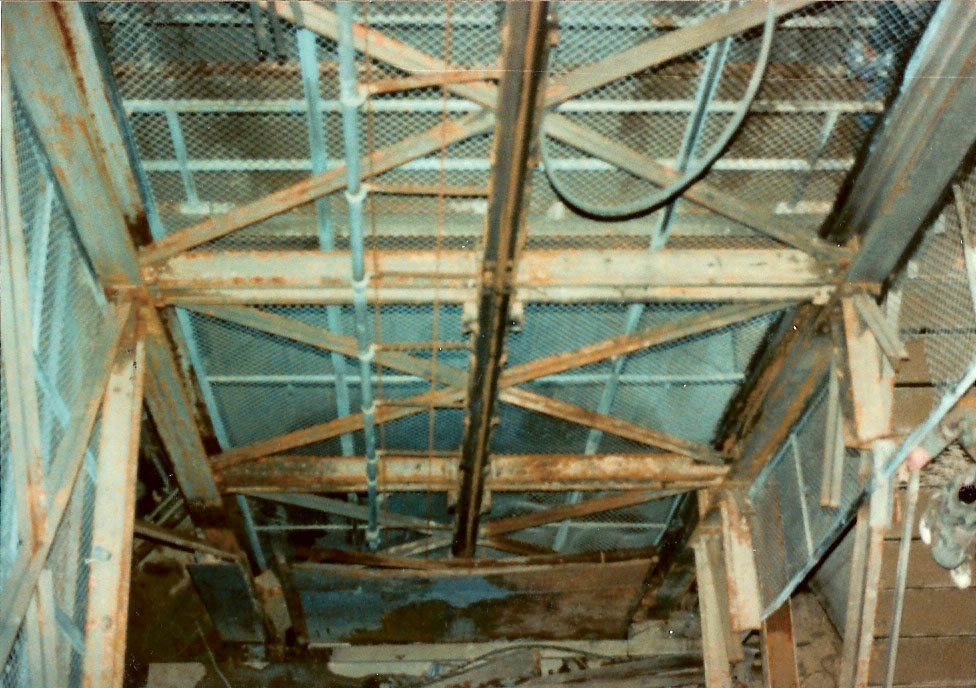
724-A:
Looking down the elevator shaft. The elevator car sets at the
bottom strewn with junk.
Photo
courtesy of Fred Epler
|
|
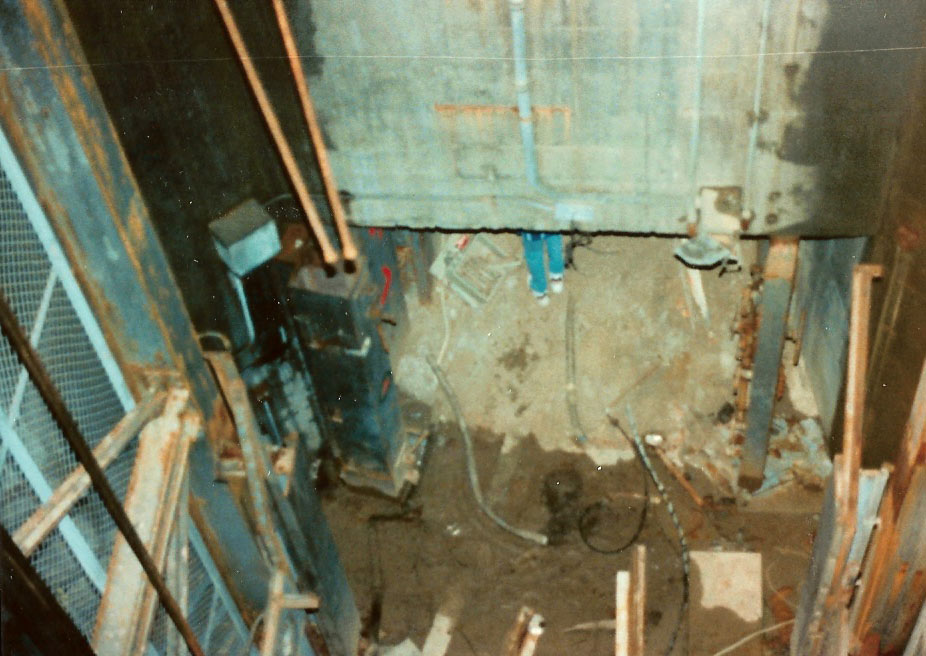
724-A:
The bottom of the silo coming within sight. Some of the structural
steel beams that would block this view have been removed during
salvage. The 8'x8' portal blast doors stand open and you can see
mud and moisture at the bottom.
Note
that the doors open outward. This is a deliberate design that
makes the doors resistant to explosions and overpressures. There
is a lip around the doorway that prevents the doors from being blown
inward by an explosion.
Photo
courtesy of Fred Epler
|
The
air smelled wet and the incessant dripping of water surrounded me.
What is all this? I wondered. I was afraid to move about
much because the floor looked like it had holes in it and I was worried
I might trip or fall. I constantly shined my light on the floor to
see that it was safe, and making tentative steps in search of solid
flooring.
Confident
at last of my footing, I looked up to see where I'd just come from.
|
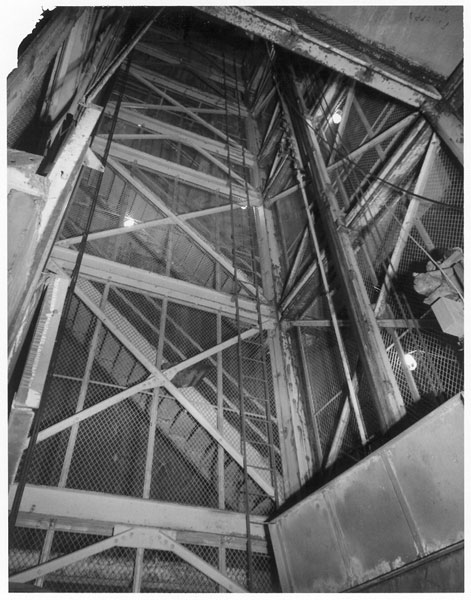
724-C,
2005: A great long exposure shot of the entry portal. This test
polaroid (yes polaroid in B&W) was discarded after setting up for a
photo with a medium-format camera. This was one of a series of
photos of Lowry 724-C to be included in the National Archives.
Photo
by Harry Weddington
|
|
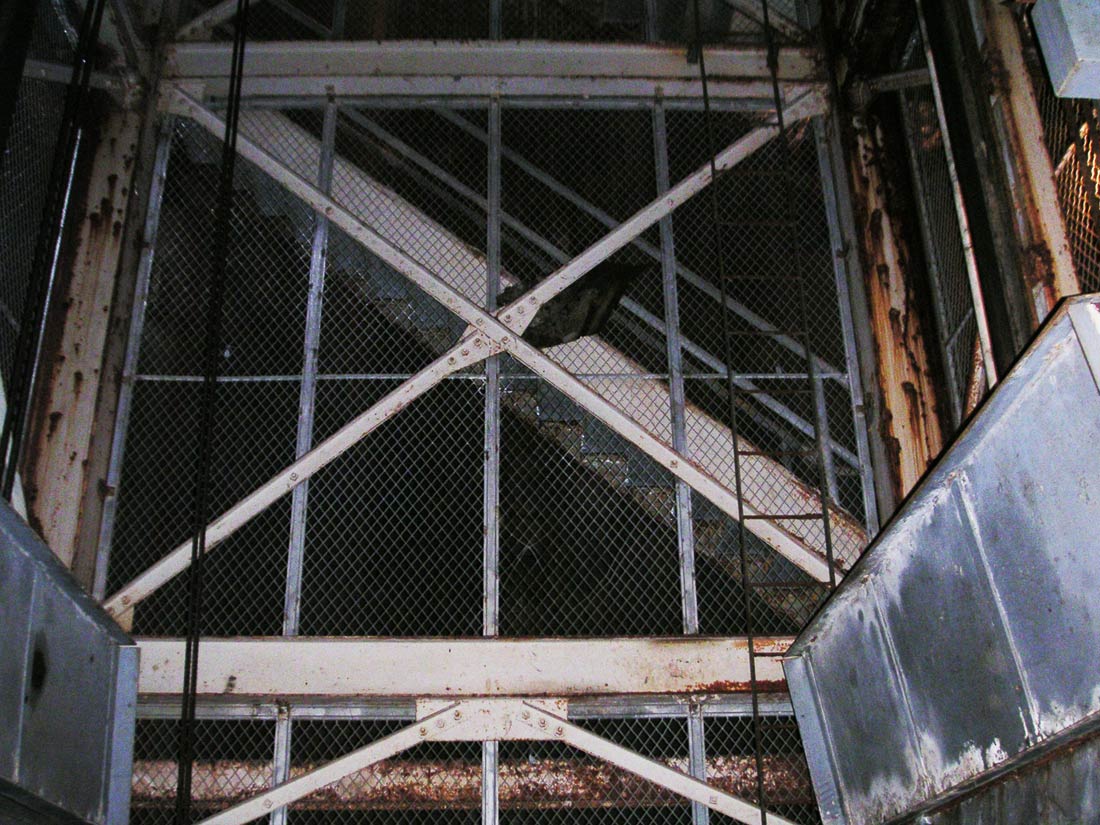
724-C,
2005: At the bottom of the portal silo. The sides of the elevator
car stand at each side. The stairs can be seen heading
upward. Behind the wall directly ahead is where the motor for the
elevator is located. I keep kicking myself for not getting a
picture of it!
|
|

724-C,
2005: Looking straight up the elevator shaft at the closed silo
doors. A temporary power cable runs at an angle across the
elevator cables. This was installed in 2000 to provide power to
the underground complex at the time. More permanent power had been
routed in by the time this photo was taken.
|
The
way back to the surface stretched off into the darkness. I could see
the doors far above, at what seemed like 10 stories up even though the
reality was that it was much less than that.
|

724-C,
2005: Looking at the elevator car interior with it's distinctive light
fixtures and control panel.
|
|

724-C,
1999: Another look at the elevator car. The extension cord is
powering the work lights in the stairs.
|
|
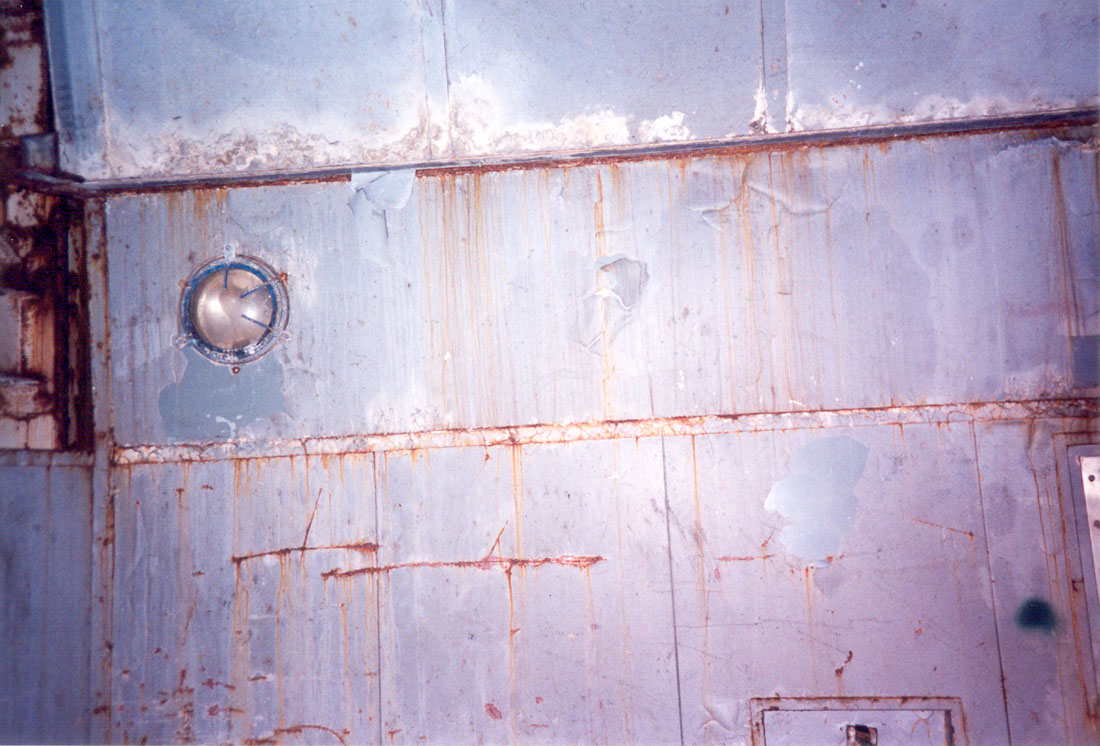
724-C,
2005: More of the elevator interior. The elevator is about 10 feet
by 10 feet at had 3 "stops": The surface; just below the
surface below the doors; the bottom of the silo.
|
|

724-C,
2005: Freight elevator controls inside the car
|
|
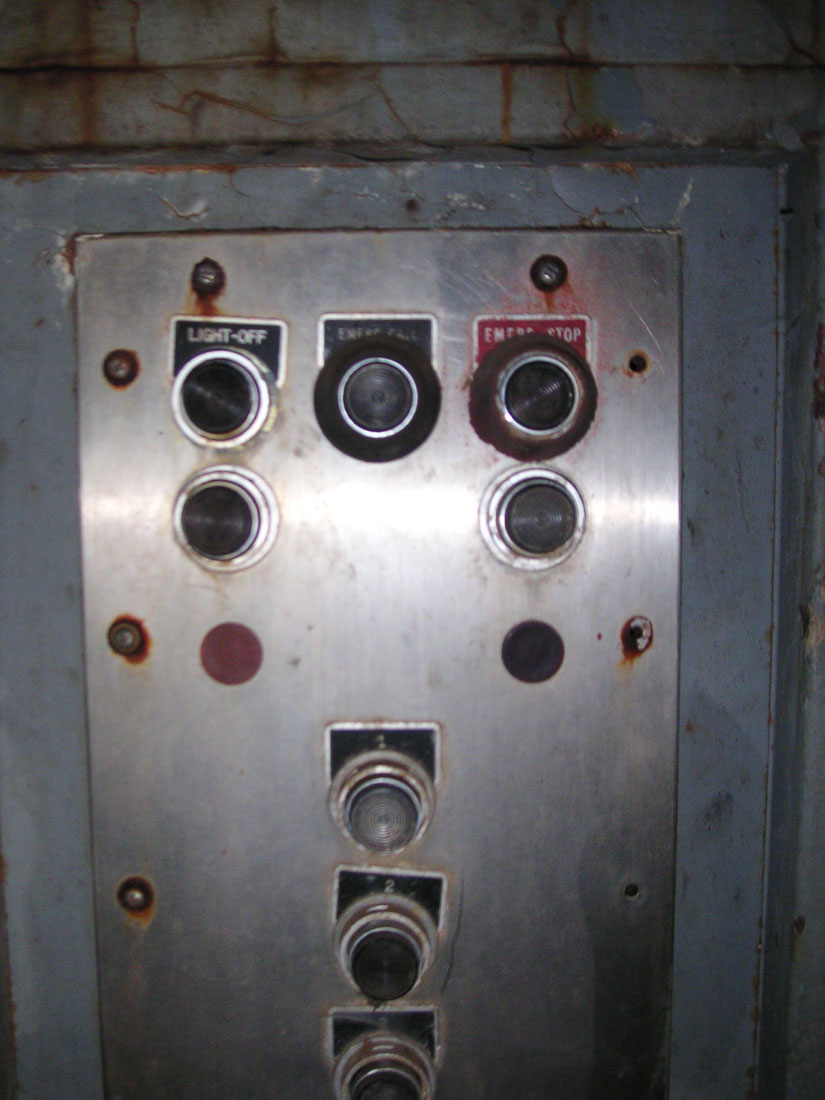
724-C,
2005: A closer look at the elevator controls
|
|
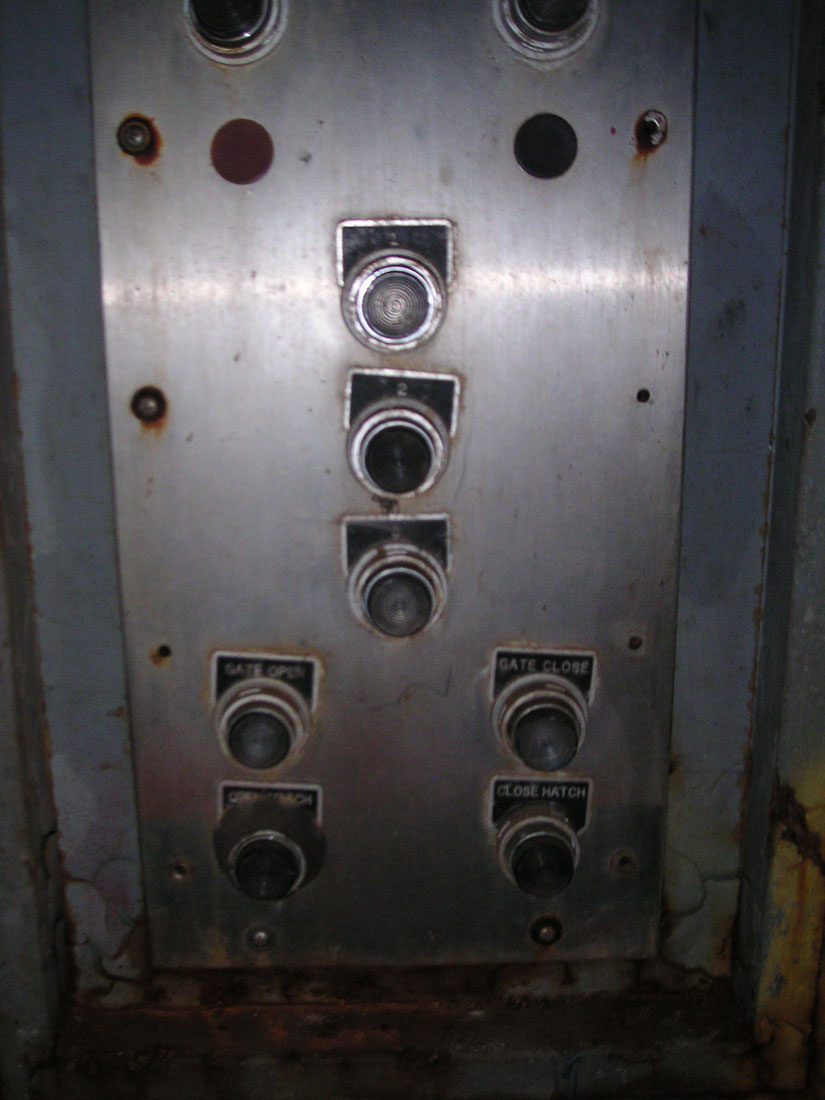
724-C,
2005: The rest of the controls
|
|

Larson
568-B: The elevator car setting on the surface
Photo
courtesy of Fred Epler
|
|
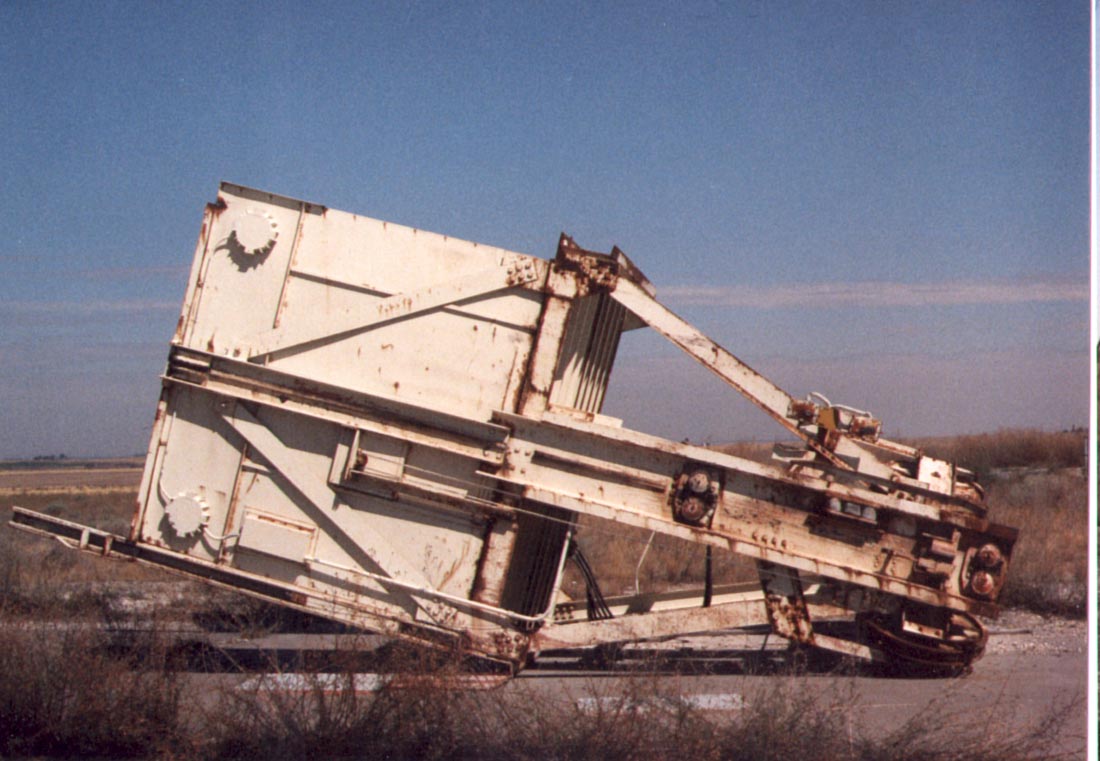
Larson
568-B: Another shot of the displaced elevator car. This view shows
the special design of the elevator that allowed it to be raised to the
surface by having the pulleys run quite a distance underneath the
car. This extra height allowed the car to travel up to ground
level.
Photo
courtesy of Fred Epler
|
|
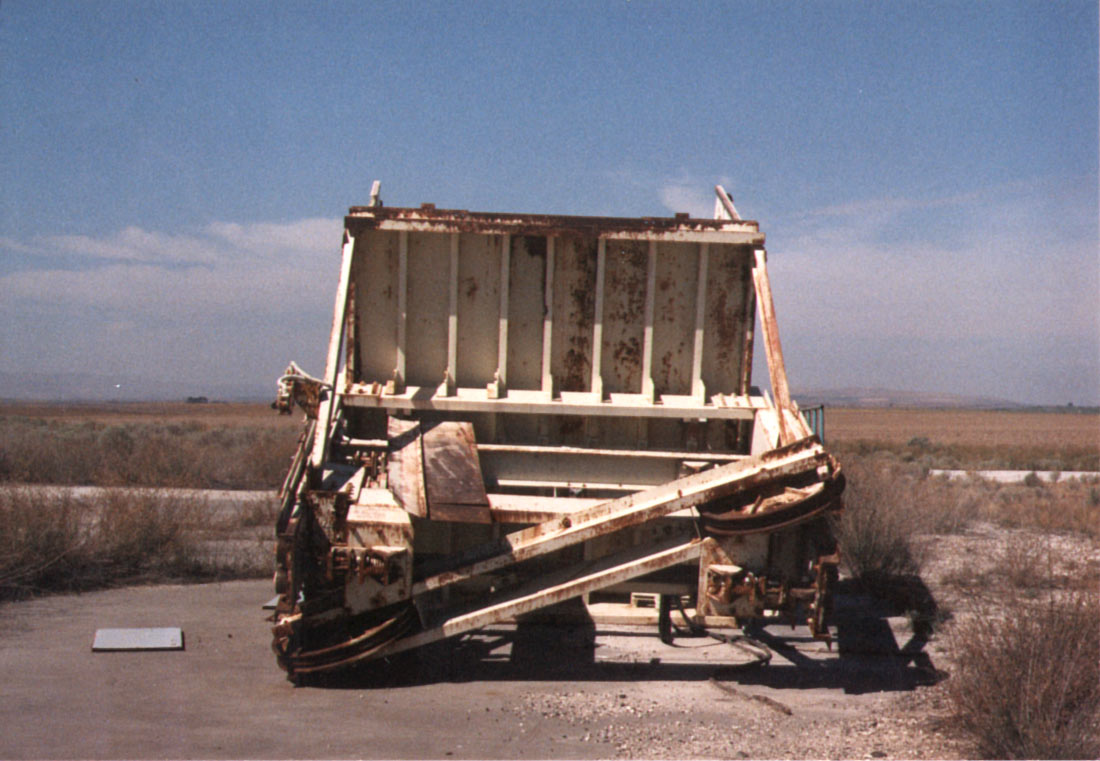
Larson
568-B: Underside of the elevator car showing the pulleys
Photo
courtesy of Fred Epler
|
|

Lowry
725-A, circa 1985: The elevator motor and drive mechanism viewed from
the walkway above.
Photo
courtesy of Fred Epler
|
|

Lowry
725-B, 1978: Elevator motor and mechanism.
Photo
courtesy of Fred Epler
|
|
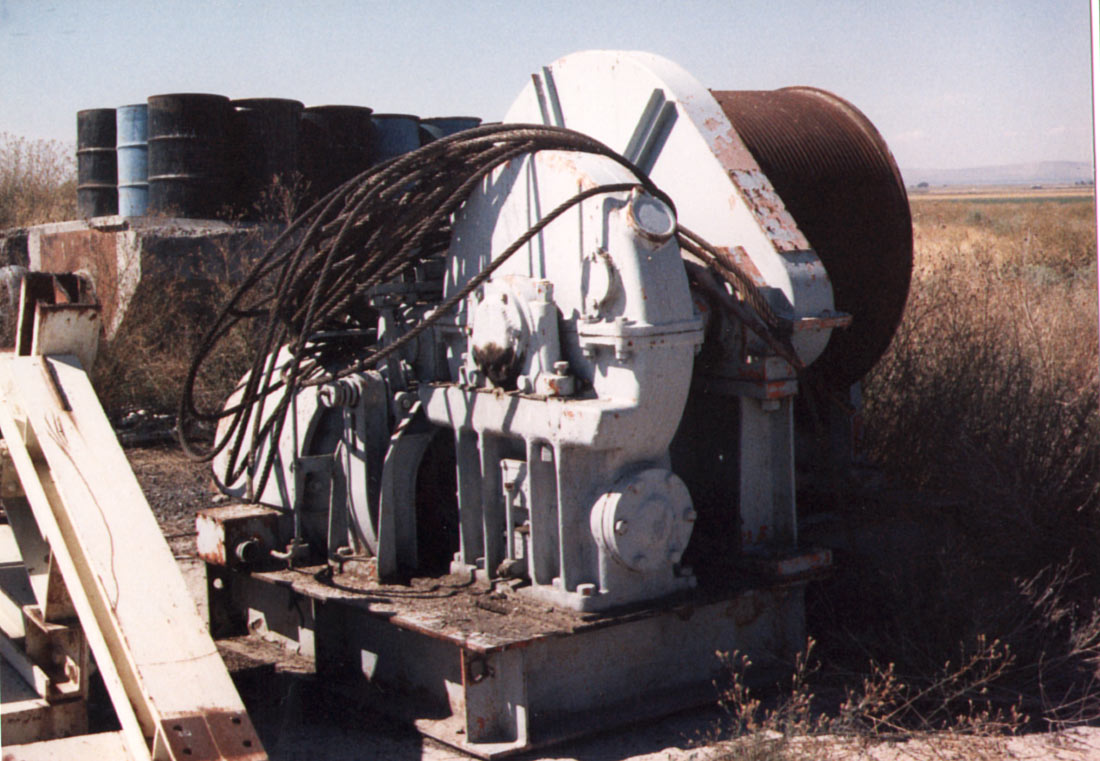
Larson
568-B: The freight elevator motor, gear train, cable and cables
sheaves. You can see the large gearbox here that contains a drive
gear about 3 feet in diameter.
Photo
courtesy of Fred Epler
|
|
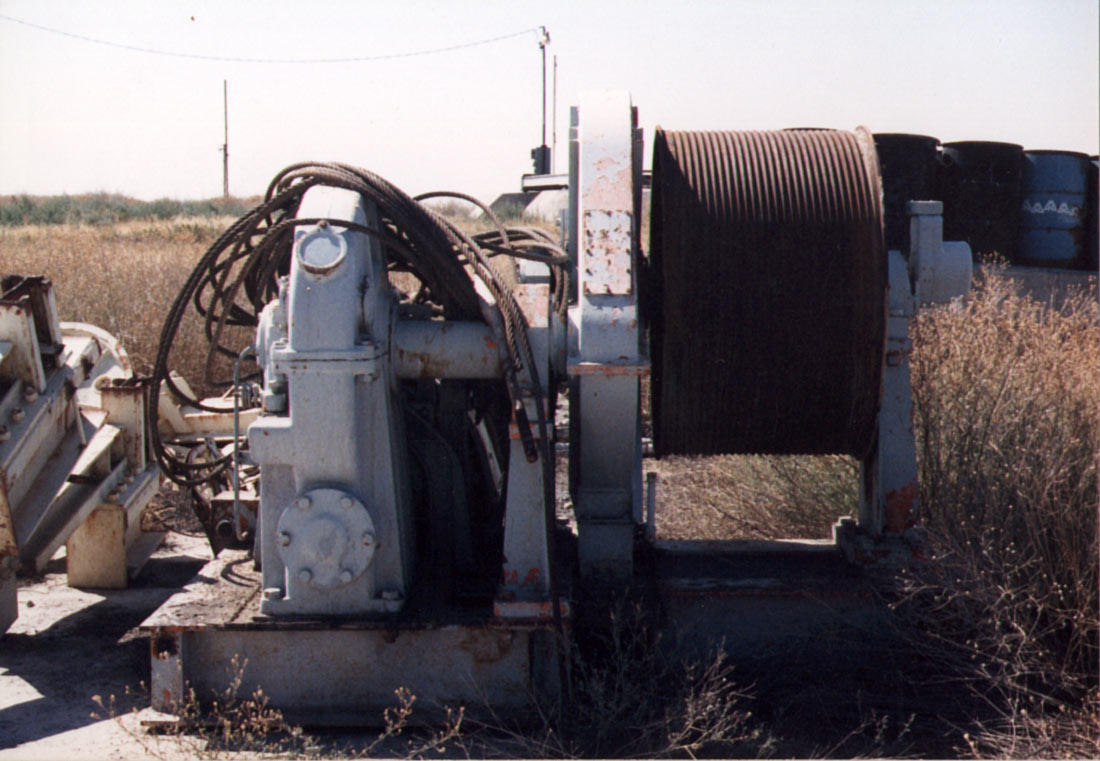
Larson
568-B: Another look at the elevator motor assembly which has been
removed and abandoned at the surface for some reason. Yes, it's
another fine Otis Elevator product folks.
Photo
courtesy of Fred Epler
|
|
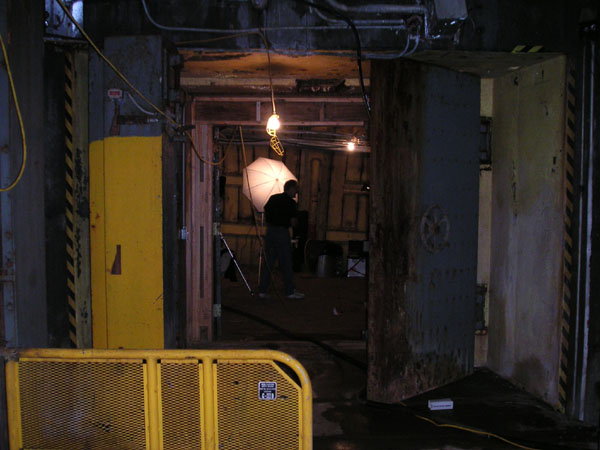
724-C,
2005: Looking out from inside the elevator at the bottom of the portal
silo. The 8'x8' blast doors can be seen framing the figure of the
ACoE photographer Harry Weddington, hard at work setting up a shot of
the main tunnel junction (T.J.#10).
Harry
has worked for the Army Corps. of Engineers for many years documenting
ACoE projects around the world. He was on site at 724-C to take
photos of the Titan 1 complex for the National Archives. Myself
and 724-C's former owner were along as consultants and to assist with
the work.
|
There
was so much to see that I'm sure we rushed through the portal silo into the
unknown tunnels beyond. The huge blast doors were larger than any bank
vault door I'd seen; the wheel was frozen and would not turn. We
peered into the murky water at the bottom of the silo and moved on.
|

724-C,
2005: Right blast door from the outside
|
|

724-C,
2005: Blast door from the inside showing the locking mechanism
|
|
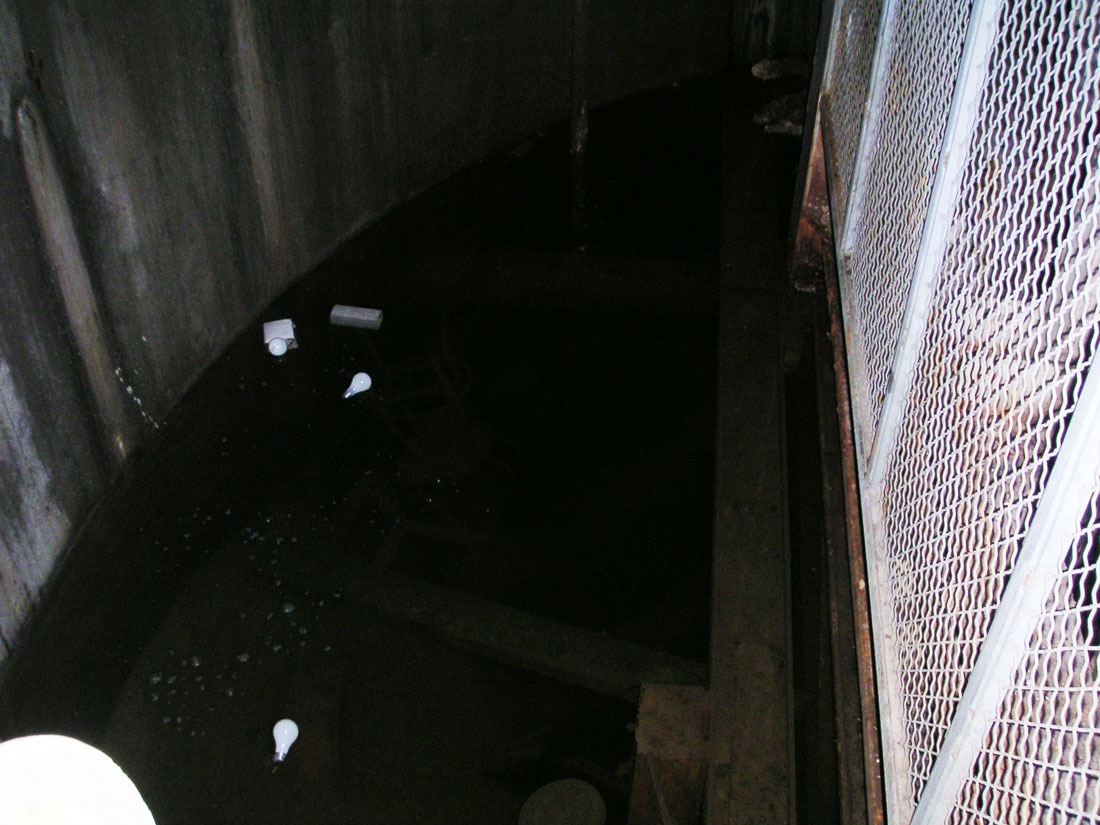
724-C,
2005: The very bottom of the portal silo, below the level of the
elevator car interior. There is about 10 feet or more of empty
space to accommodate the bottom portion of the elevator car. As
you can see in this photo, all the water that leaks in has been
accumulating here. Through the water you can see a chair and other
discarded junk a the bottom. Floating on the surface of the water
you can see several light bulbs that I will confess to having dropped
there from far above as I replaced the lights in the stairs. Also
visible are beams supporting the elevator shaft structure. Back
and to the right is where the elevator motor can be found.
A
ladder just out of sight toward where I stood provided maintenance
access to the area below the elevator (except when it's flooded like
this).
|
Just
beyond the blast doors there was a broad tunnel that branched off into
the darkness. We could see more tunnels leading away from this
intersection that seemed to go in all directions. It was then that
I began to realize that this place was so much larger than I had ever
thought.
|

724-C,
2005: Looking from the main tunnel junction into the portal silo.
The yellow gate is part of the elevator car, but it appears that it may
not be original.
In
the foreground you can see a wooden frame has been fitted to mount two
doors taken from the control center into the silo doorway. You can
see these doors wouldn't properly lock and I think they were in fact
fitted with a hasp to allow locking with a padlock. You can also
see where the glass was broken out of the right side door so this was
not a very effective means of keeping people out.
|
|

724-C,
1999: Portal silo entrance with it's awkward plywood door frame at
right. The electrical box is not original and I think it carried
an alarm system contact on the doors and perhaps some lighting.
|
|
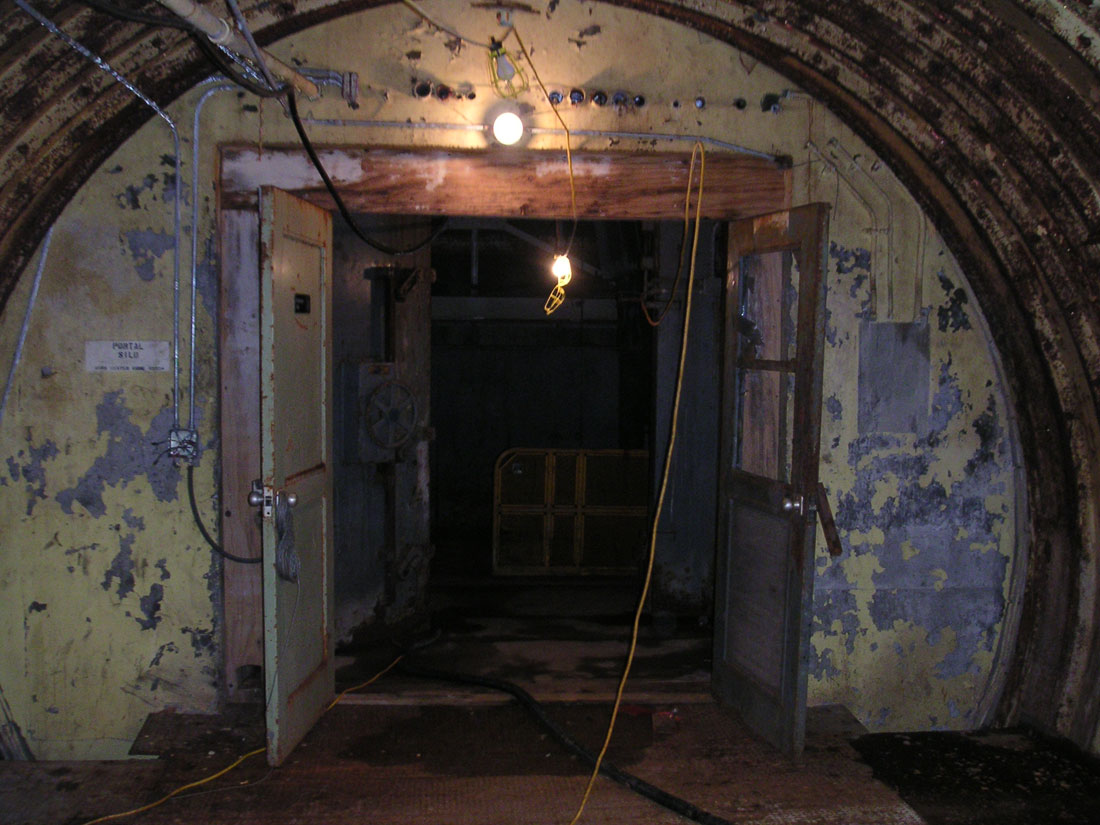
724-C,
2005: Wider view looking into the portal silo from the main tunnel
junction.
|
|

Historical
photo of an unknown Titan 1 site in sparkling new condition. The
old place hasn't looked this good in a long, long time.
Photo
courtesy of Fred Epler
|
Now
you're deep inside the complex surrounded by tons of concrete and
steel. Where would you like to go next? Click on the links
below to look around in the main tunnel junction (T.J.#10) or to see the
main map to visit elsewhere.
T.J.
#10 or Go
to Main Map

| Contact |
Site Map | Links
|
Hosted by
InfoBunker





























